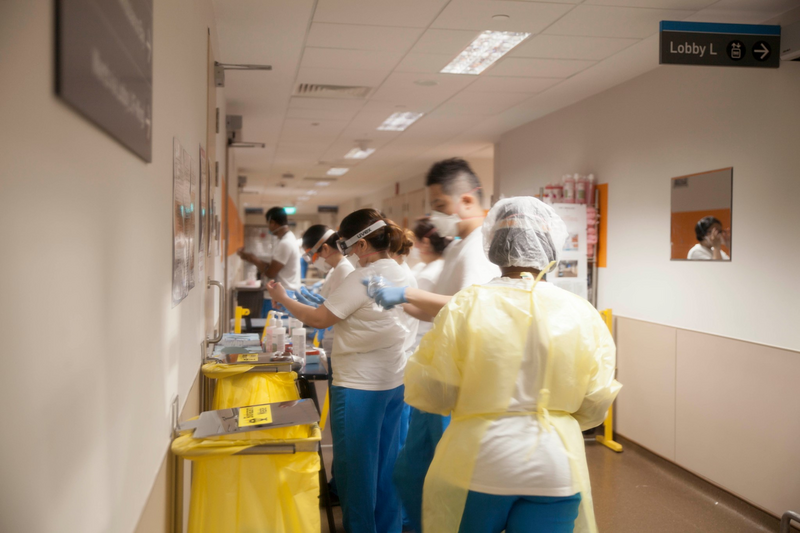ATD Blog
Training Practices in Singapore Hospital
Fri May 15 2020

While following the daily updates of COVID-19 cases across the nation and world, I happened to come upon the number in Singapore. Something caught my eye that stood out starkly: The patient-to-doctor transfer rate of the virus was significantly lower there than many other nations also battling the contagious spread. Why did Singapore have lower numbers?
Curiosity got the best of me, and I reached out to our contacts at Tan Tock Seng Hospital. On a quiet Wednesday night, I dialed in to our virtual meeting to be greeted by David Dhevarajulu, executive director for the Center for Healthcare Innovation, and David Hendrick, Jr., director of the Center for Healthcare Innovation—People Development. It was a bright Thursday morning for them and though masked, I could hear the warm smiles in their voices. A seemingly simple request to explore their stats ended up opening an insightful conversation about ways their health system systemically and structurally favored training and emergency preparedness.
Their experience fighting SARS in the early 2000s had prepared them for COVID-19. The lessons learned through trial and error allowed them to restructure their approach to training, clinician well-being, and patient safety, making them much better positioned when SARS version two came around as coronavirus.
Near-Term Solutions We Can Adopt: Structural Approach to L&D
Collective Leadership
Tan Tock Seng’s hospital executives work in tandem with the L&D department to identify essential training areas. They view success from a holistic approach, seeing the facility’s function as various departments that are all deeply interconnected. Rather than having siloed departments and having the L&D team handle training on their own, the executives are invested in the growth of their employees and stay actively involved in the processes, setting metrics so that 60 to 90 percent of the training that is delivered can be applied to everyday scenarios practitioners face. Furthermore, they have a delegated team to merely develop learning content (separate from trainers). This 150-person team works to create modules, focusing on microlearning and virtual lessons, so that employees can continuously be trained throughout their tenure as an employee, both in-person as well as during their own time. With these efforts in place, the hospital is audited for performance management on an annual basis to ensure learning and development is given its due importance.
Periodic Drills
Dhevarajulu and Hendrick explained how doctors in the hospital had been acutely trained for emergency situations. Emergency training is a mandatory part of onboarding; so far as each doctor has their mask size included on their badge. In cases like the coronavirus, the ICU doctors have been trained to handle extremely contagious viruses and treating patients in isolation and quarantine environments. Training goes outside of the mere instructional design classroom scenario. Like a “military base,” the hospital runs mock crisis simulations every few months to have employees go through the motions of emergency protocol together. By having practiced through drills, they have methodical ways to manage the crisis at hand now.
Longer-Term Solutions to Ponder: Systemic Changes to Hospitals
Building Structure for Patient Safety
After the outbreak of SARS and intense research on the spread of contagious viruses, the health system realized that risk to other hospital patients or doctors could be mitigated if infectious diseases were treated in another facility. Tan Tock Seng Hospital has an entirely separate building for patients with infectious diseases, which allows the hospital to continue treatment for other ailments and surgeries while ensuring overall patient safety. Consultation rooms have been designed with social distancing measurements in mind as well. There are appropriate distances between a patient bed and a doctor’s desk or between multiple patient beds in a ward. When the hospital was designed, various “flows” were accounted for and reflect in building structure, room size(s), hallway width(s), and the like, allowing for thorough patient and employee safety.
Managing Practitioners’ Well-Being
In addition to looking out for patient and employee physical safety, Tan Tock Seng has gone to great measures to look out for employees’ well-beings too. Alongside trainers, there is a 160-person team for the emotional and mental welfare of frontline workers. These “welfare officers” develop interventions and use them during crisis so that doctors and nurses don’t face burnout. With this special team in full force, doctors are receiving emotional care to manage their stress levels during this emergency so that they are as mentally and physically sharp as they can be.
This pandemic has thrown extreme challenges but also unique opportunities for healthcare professionals to learn not just from peers in nearby vicinities but across state lines, countries, and oceans. While Singapore and the United States operate in different ways, there is a lot to observe and share with one another. As trainers across our nation redesign lessons, incorporate new ideas, and help their health systems thrive, there are longer-term ideas we can consider to adapt to or adopt altogether to reshape how we train, support, and improve the industry.
